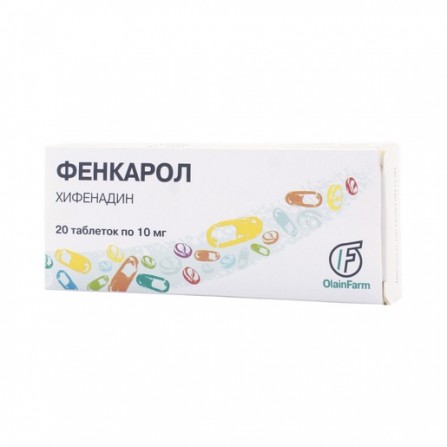Fenkarol pills 10 mg 20 pcs
Condition: New product
1000 Items
Rating:
Be the first to write a review!

More info
Active ingredients
Hifenadine
Release form
Pills
Composition
Hifenadine hydrochloride 10 mg. Excipients: potato starch - 14.5 mg, sucrose - 25 mg, calcium stearate - 0.5 mg.
Pharmacological effect
Histamine H1 receptor blocker. Prevents the development and facilitates the course of allergic reactions. It has antiallergic, antiexudative and antipruritic effect, preventing the development of allergic inflammation in the tissue. It weakens the effect of histamine, reduces its effect on vascular permeability (reducing permeability, has a decongestant effect), reduces its bronchospastic effect and spasmogenic effect on intestinal smooth muscle, weakens the hypotensive effect of histamine. Hifenadine reduces the content of histamine in the tissues (due to the ability to activate diaminoxidase - an enzyme that inactivates histamine). In the course of treatment, the antihistamine effect of Hifenadine is not reduced. It has a moderate anti-serotonin action, exhibits weak m-anticholinergic activity. It has no inhibitory effect on the central nervous system.
Pharmacokinetics
Absorption and distribution; Hifenadine is rapidly absorbed from the gastrointestinal tract, absorption is 45%, and after 30 minutes is detected in the tissues of the body. Cmax in plasma is achieved after 1 h. It has low lipophilicity, poorly penetrates through BBB. The highest concentration of the active substance is found in the liver, somewhat lower in the lungs and kidneys, the lowest in the brain (less than 0.05%, which explains the absence of a pronounced sedative and hypnotic effect) .; Metabolism and excretion; Hifenadine is metabolized in the liver .; Metabolites are excreted by the kidneys and intestines. Unabsorbed part of the drug is excreted through the intestine.
Indications
- pollinosis; - acute and chronic urticaria; - angioedema; - allergic rhinitis; - dermatosis (including eczema, psoriasis, atopic dermatitis); - atopic dermatitis; - pruritus.
Contraindications
- pregnancy; - lactation period (breastfeeding); - children's age up to 3 years (for pills of 10 mg and 25 mg); - children's and teenage age till 18 years (for pills of 50 mg); - deficiency of sucrase / isomaltase, fructose intolerance, glucose-galactose malabsorption, sincethe product contains sucrose; - hypersensitivity to the components of the drug .; Precautions should be prescribed medication for gastrointestinal, liver and kidney diseases
Use during pregnancy and lactation
The use of the drug during pregnancy is contraindicated .; If necessary, treatment with the drug breastfeeding should be stopped.
Dosage and administration
The drug is taken orally after a meal .; Dosage regimen of the drug is the same for all indications for use. The dosage of Hifenadine can be influenced by the severity of the allergic reaction, the individual sensitivity of the patient, as well as the severity of possible side effects .; Adults appoint 50 mg 1-4 times / day or 25 mg 2-4 times / day. The maximum daily dose is 200 mg. The course of treatment is on average 10-20 days. If necessary, repeat the treatment .; Children aged 3 to 7 years - 10 mg 2 times / day; between the ages of 7 and 12 years, 10-15 mg 2-3 times / day; over 12 years old - 25 mg 2-3 times / day. The course of treatment is 10-15 days.
Side effects
On the part of the digestive system: dryness of the oral mucosa, nausea, vomiting .; From the side of the central nervous system: drowsiness, headache .; Other: allergic reactions.
Overdose
Symptoms: dry mucous membranes, headache, vomiting, abdominal pain and other symptoms of dyspepsia .; Treatment: gastric lavage, taking activated carbon, conducting symptomatic therapy .; In case of overdose, the patient should consult a doctor.
Interaction with other drugs
Hifenadine does not enhance the inhibitory effect of ethanol and hypnotic drugs on the central nervous system .; Possessing weak m-holinoblokiruyuschimi properties, the drug can reduce the motility of the gastrointestinal tract, which increases the absorption of slowly absorbed drugs (for example, indirect anticoagulants - coumarins).
special instructions
The absence of a pronounced m-anticholinergic effect allows the drug to be prescribed to patients who are contraindicated in antihistamines with m-anticholinergic blocking activity .; Use in pediatrics; Children are recommended to appoint Fenkrol in the form of pills 10 mg or 25 mg. Influencing the ability to drive vehicles and control mechanisms; Fenkarol is approved for use by people whose work requires high concentration of attention and a quick psychomotor reaction (driving and working with mechanisms), but it is recommended to preliminarily determine (through short-term administration) whether the drug has a sedative effect. effect.




